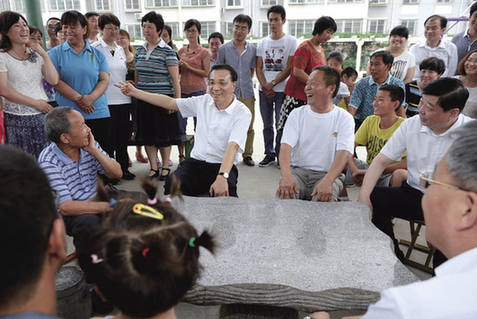Shandong’s Urbanization Paradigm
By WANG ZHE
Shandong, a big industrial and agricultural province with a large population, has summarized a clear urbanization concept. The province unveiled on September 3, 2014 its development plan (2014-2030) for a new rural community and new rural area. As a result, some 14,000 villages, of a population of around 14 million, will be combined into cities and towns. Another 21,000 villages will be built into new rural communities, housing 18 million people. The urbanization reforms will also retain around 30,000 villages.
|
 |
|
Premier Li Keqiang chats with residents of Yuanqiao Village during an inspection of Dezhou, Shandong Province on July 24, 2014. |
Vanishing Villages
Shandong’s rural population fell from 68.8 million in 2000 to 54.82 million in 2013, and that of its rural permanent residents dropped from 57.82 million to 45.02 million. By 2030, the province’s rural population is estimated to decline to 37.5 million and its rural permanent resident population to 29.7 million. This means that by 2030 more than half of Shandong’s villages will disappear. As urbanization entails building some 7,000 new communities, this wane in rural population is inevitable.
Urbanization of localities nearby cities is the main feature of Shandong’s transfer of rural population. The province’s counties and key towns will absorb the bulk of it. Rural population will inevitably gather in new rural communities, and non-farming occupations will become important sources of extra income for farmers. Shandong will improve infrastructure and public service facilities in both county-level cities and towns. Villages will inevitably merge amid the steady redistribution of population and diminution of villages.
The rapid disappearance of villages and homes that have stood for millennia will have certain unavoidably negative consequences. House demolitions in other places have not taken into account traditional village layouts or the preservation of their historical features. Construction of certain new rural communities has also failed to consider the natural landscapes and historical culture that constitute their rural character. This is why Shandong has retained 30,000 villages in the course of its urbanization reform.
Meanwhile, the province has strengthened its protection of historical sites. Throughout renovations to time-honored architecture, streets, villages and towns, Shandong has ensured that new constructions organically integrate traditional culture and modern functions. The province takes pains to preserve the authenticity, integrity and continuity of intangible cultural heritage through rational utilization, under the premise of effective protection.
Improve Urbanization Quality
By 2020, Shandong’s urbanization of permanent population will reach 62 percent. During the process, seven million farmers will be transferred who together with another 10 million rural residents living in the villages of urban areas, will acquire urban citizenship. Meanwhile, the province has implemented different residence migration policies to suit small and medium-sized cities as well as metropolises. They make small cities and towns freely accessible, while medium-sized cities will gradually open in an orderly way, and big cities will relax residence migration restrictions. Each year, an estimated one million rural people will become urban residents.
